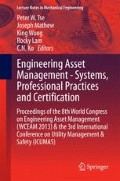Abstract
This paper deals with advanced computational techniques for taking account the human factors in Intelligent Manufacture Systems. A Cyber-Physical Systems (or CPS) is a system that combines and coordinates physical and computational elements. The CPS incorporates the ability to act in the physical world with the intelligence of cyber world to add new features to real-world physical systems [1]. Among the various fields of activity of the CPS, can cite security systems, robotics, education, among others. Industrial environments are characterized by being favorable places for the introduction of technologies aimed to facilitate the interaction/mediation between human and machines. In this paper, we propose to use CPS for taking account human factors in Maintenance Estrategies. The proposal, called TOOGLE-IMS, aims at developing a Human Computer Interface (HCI) for Intelligent Maintenance Systems (IMS).
Access this chapter
Tax calculation will be finalised at checkout
Purchases are for personal use only
Notes
- 1.
Bullet Physics Library. http://www.bulletphysics.com.
References
Li Q, Qin W, Han B, Wang R, Sun L (2011) A case study on REST-style architecture for cyber-physical systems: Restful smart gateway. Comput Sci Inf Syst 8:1317–1329
Muller A, Marquez A, Iung B (2008) On the concept of e-maintenance: review and current research. Reliab Eng Syst Saf 93:1165–1187
You M, Li L, Meng G, Ni J (2010) Cost-effective updated sequential predictive maintenance policy for continuously monitored degrading systems. IEEE Trans Autom Sci Eng 7:257–265
Peysson F et al (2007) New approach to prognostic systems failures. In: Proceedings of the 17th IFAC World congress
Chattopadhyay D, Dasgupta R (2012) A novel comprehensive sensor model for cyber physical system: Interoperability for heterogeneous sensor. In: 2012 sixth international conference on sensing technology (ICST), pp 179–183, 18–21 Dec 2012
Huang Y, Li G (2010) Descriptive models for/internet of things. In: International conference on intelligent control and information processing (ICICIP), 2010, pp 483–486
Koshizuka N, Sakamura K (2010) Ubiquitous id: standards for ubiquitous computing and the internet of things. Pervasive Comput IEEE 9(4):98–101
Tan Y, Vuran MC, Goddard S, Yu Y, Song M, Ren S (2010) A concept lattice-based event model for Cyber-Physical Systems. In: Proceedings of the 1st ACM/IEEE international conference on cyber-physical systems (ICCPS’10). ACM, New York, pp 50–60
Yan S, Zhu Y, Zhang Q, Wang Q, Ni M, Xie G (2012) A case study of CPNS intelligence: provenance reasoning over tracing cross contamination in food supply chain. In: 2012 32nd international conference on distributed computing systems workshops, pp 330–335
Shi J, Wan J, Yan H, Suo H (2011) A survey of cyber-physical systems. In: 2011 international conference on wireless communications and signal processing (WCSP), pp 1, 6, 9–11 Nov 2011. doi:10.1109/WCSP.2011.6096958
Pophaley M, Vyas R (2013) Plant maintenance management practices in automobile industries: A retrospective and literature review. JIEM 2010 3(3):512–541. ISSN: 2013-0953; Print ISSN: 2013-8423
Choi B, Kim B (2000) A human-centered VMS architecture for next generation manufacturing. In : Proceedings of 2000 international CIRP design seminar, Haifa, Israel, 16–18 May 2000, pp 169–174
Lebold M, Thurston M (2001) Open standards for condition-based maintenance and prognostic system. In: Proceedings of MARCON 2001—fifth annual maintenance and reliability conference, Gatlinburg, USA, 2001
Henderson S, Feiner S (2010) Opportunistic tangible user interfaces for augmented reality. IEEE Trans Vis Comput Graph 16:4–16
Quigley M, Gerkey B, Conley K, Faust J, Foote T, Leibs J, Berger E, Wheeler R, Ng A (2009) ROS: an open-source Robot Operating System. ICRA workshop on open source software
Roosendaal T, Selleri S (eds) (2004) The official blender 2.3 guide: free 3D creation suite for modeling, animation, and rendering, vol 3. No Starch Press, San Francisco
Fikes RE, Nilsson NJ (1972) STRIPS: A new approach to the application of theorem proving to problem solving. Artif Intell 2(3):189–208
Bonet B, Geffner H (2011) mGPT: a probabilistic planner based on heuristic search. arXiv preprint arXiv: 1109.2153
Song Y, Kautz H, Lee R, Luo J (2013) A general framework for recognizing complex events in Markov logic. PAIR 2013: AAAI workshop on plan, activity, and intent recognition, Bellevue, WA
Acknowledgments
The research leading to these results has received funding from Coordenação de Aperfeiçoamento de Pessoal de Nível Superior (CAPES) in cooperation project, between Brazil and Germany—BRAGECRIM, named Integrating Intelligent Maintenance Systems and Spare Parts Supply Chains (I2MS2C) in the context of visualization.
Author information
Authors and Affiliations
Corresponding author
Editor information
Editors and Affiliations
Rights and permissions
Copyright information
© 2015 Springer International Publishing Switzerland
About this paper
Cite this paper
Filho, N.D. et al. (2015). Human Computer Interface (HCI) for Intelligent Maintenance Systems (IMS): The Role of Human and Context. In: Tse, P., Mathew, J., Wong, K., Lam, R., Ko, C. (eds) Engineering Asset Management - Systems, Professional Practices and Certification. Lecture Notes in Mechanical Engineering. Springer, Cham. https://doi.org/10.1007/978-3-319-09507-3_20
Download citation
DOI: https://doi.org/10.1007/978-3-319-09507-3_20
Published:
Publisher Name: Springer, Cham
Print ISBN: 978-3-319-09506-6
Online ISBN: 978-3-319-09507-3
eBook Packages: EngineeringEngineering (R0)

